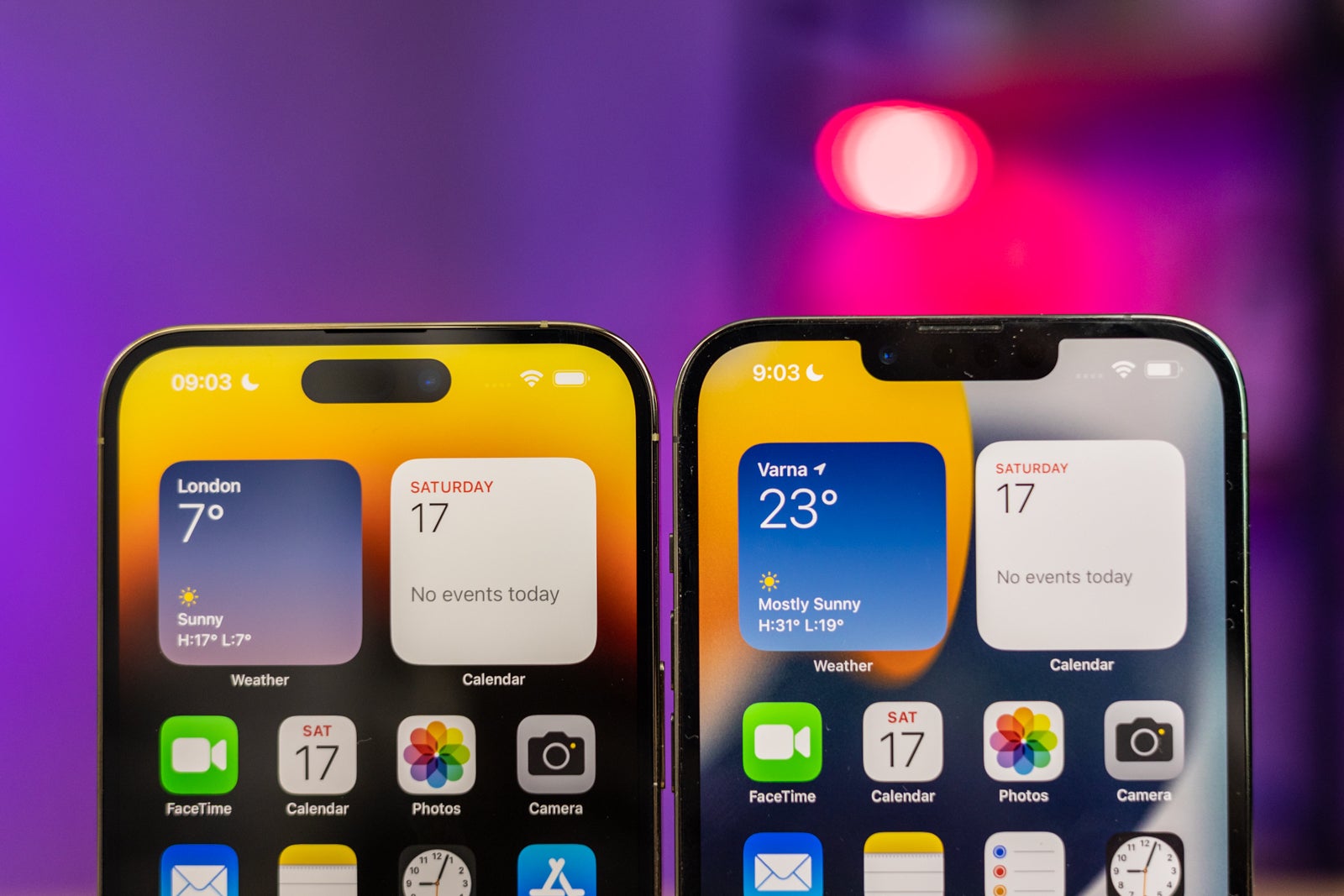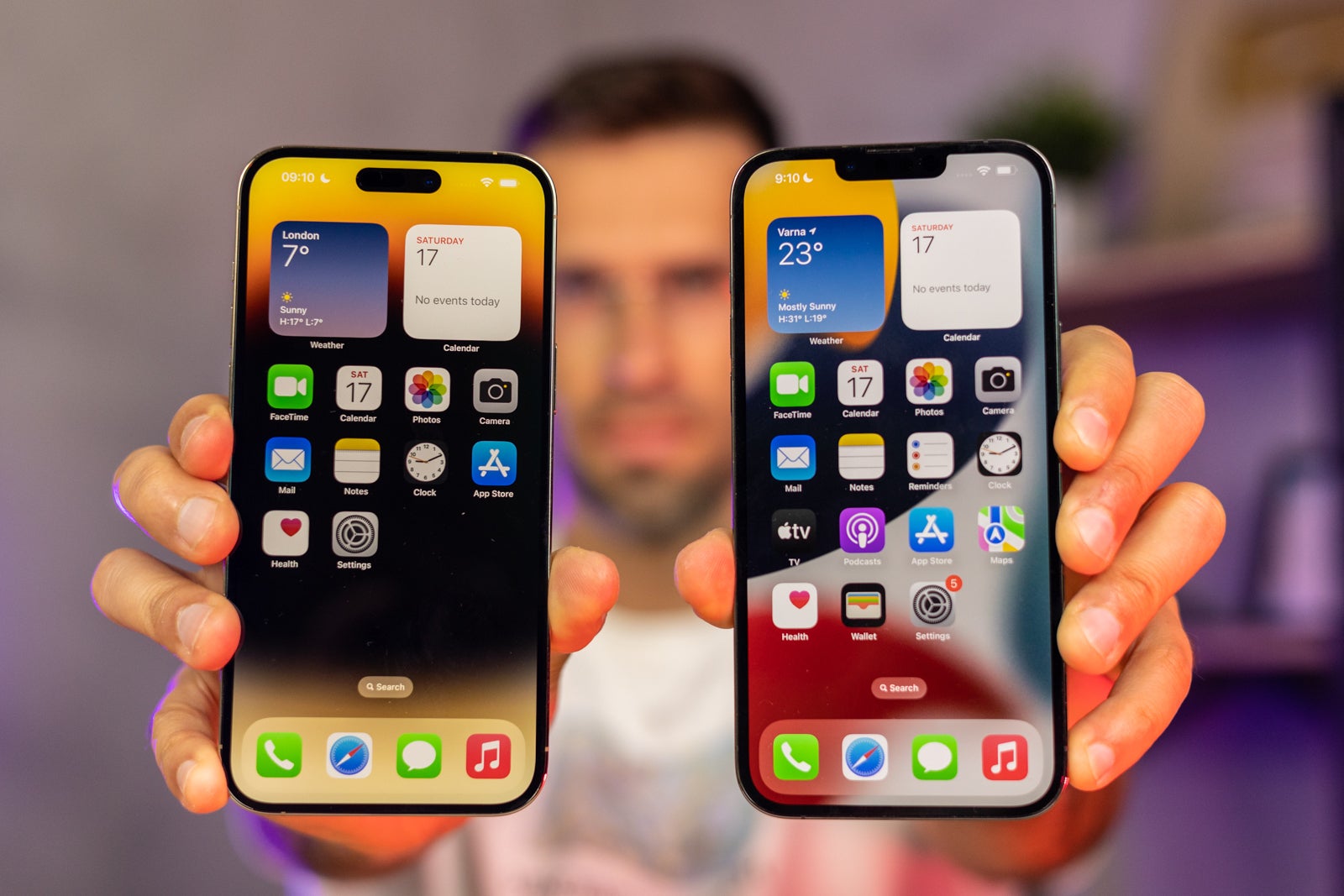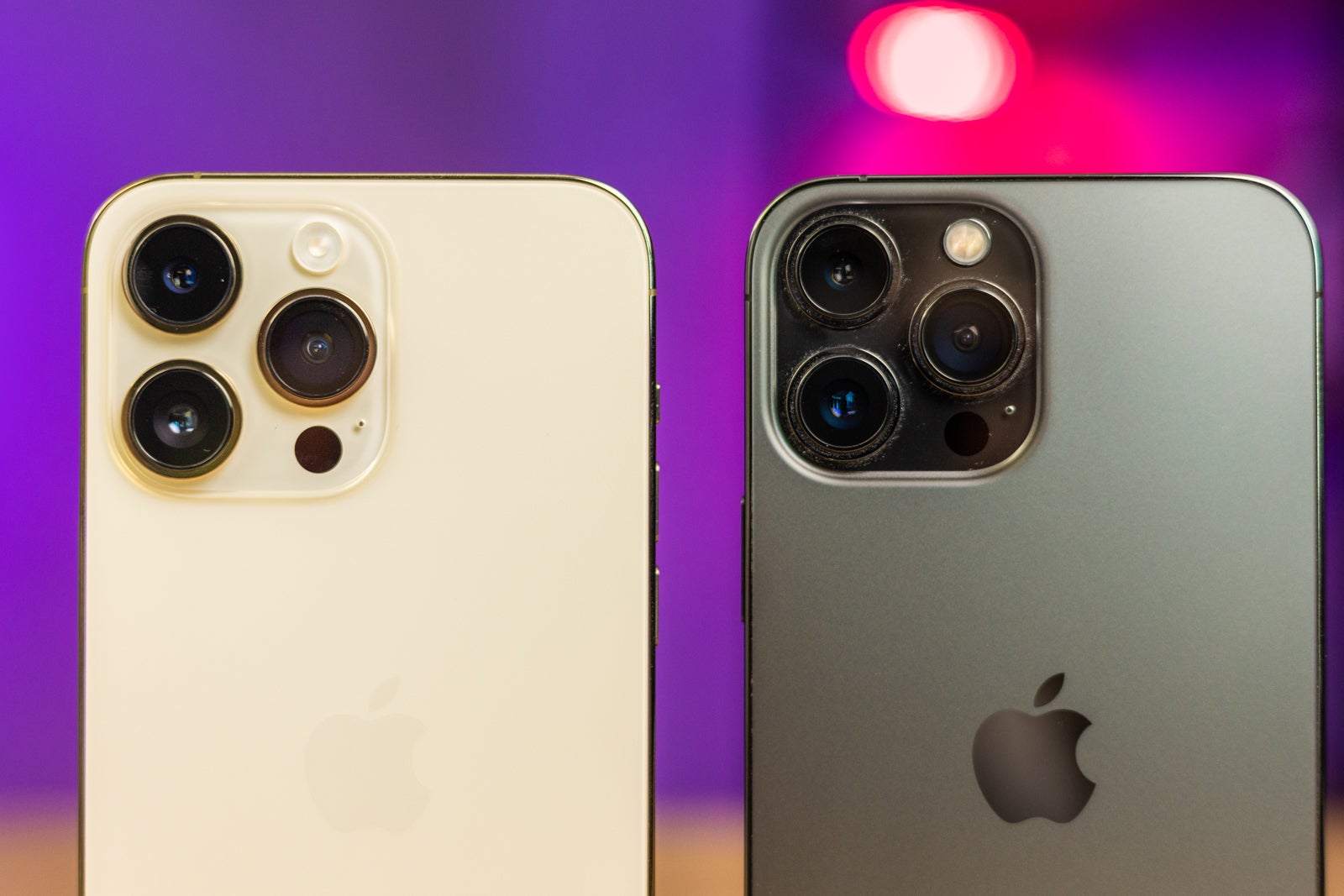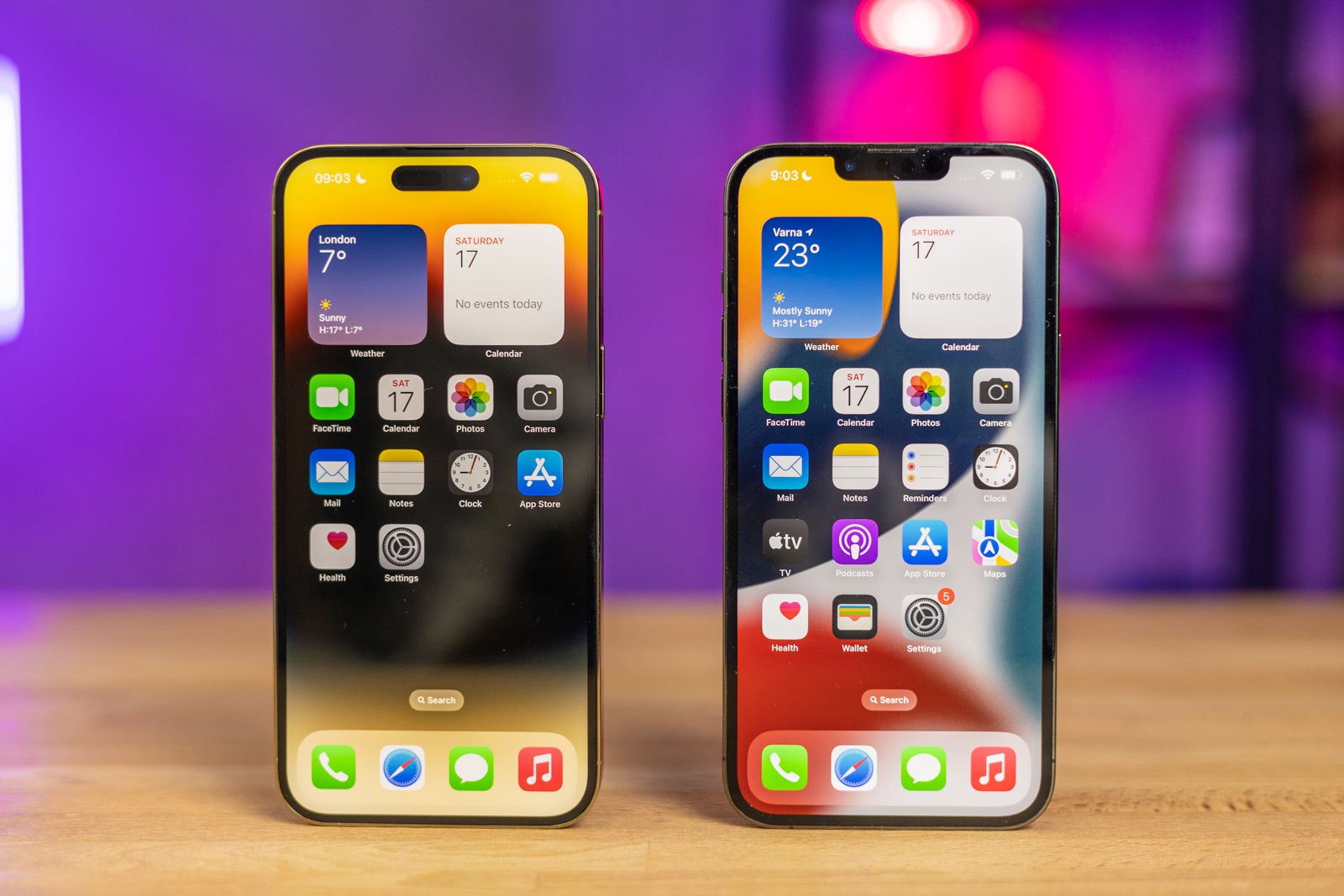Intro
What does the new iPhone 14 Pro Max bring to the table and how is it different from the already fast and long-lasting iPhone 13 Pro Max?
There are a few things, but chief among them are two new features: a higher resolution 48MP main camera and the new Dynamic Island that replaces the notch.
Of course, Apple is also bringing its most advanced A16 Bionic chip to the new model, and along with the larger camera sensor, come a few other photo and video improvements.
So let’s dive in those differences between the iPhone 14 Pro Max and iPhone 13 Pro Max and see if it’s worth upgrading…
- Dynamic Island replaces the notch
- Faster A16 Bionic chip
- Improved display with 1Hz refresh rate and Always-On function
- New 48MP main camera
- 4K Cinematic video, new Action Mode stabilization
- Satellite connectivity
- Same battery life, same charging speeds
Table of Contents:
Design and Display Quality
Design is mostly unchanged
(Image credit – PhoneArena) iPhone 14 Pro Max in gold vs iPhone 13 Pro Max in graphite
The iPhone 14 Pro Max largely keep the looks of its predecessor with the same screen size, flat sides and the familiar glass and stainless steel materials.
What you will notice, though, is the new Dynamic Island pill-shaped system on the front, which replaces the notch. It eats up less space, and gives the new iPhone 14 Pro series a look unlike any other phone. However, most impressively, it acts as a sort of a status bar for your current iPhone doings: playing back music – you get a tiny waveform and album art; using the maps – you get a little icon; phone running low on battery – the warning pops up there. Cool! But is that a profound change that would warrant an upgrade? Not really.
Another notable feature that the iPhone 14 Pro Max has over its predecessor is an Always-On display. Android has had this for years, and now it’s finally on the iPhone. Apple is using the new 1Hz refresh rate so that it can dim the wallpaper with minimal battery drain. The one thing to know here is that it might just be a bit too “on” and a bit doo distracting, but it’s nice to be able to glance at your lockscreen. We just wish Apple adds a bit more customization options to this.
In terms of color options, the iPhone 14 Pro Max has four: deep purple, gold, silver, and space black. The iPhone 13 Pro Max has five color variants: alpine green, silver, gold, graphite, and sierra blue.
What is not changing are the contents of the box: you only get a Lightning cable and no charger inside.

(Image credit – PhoneArena) iPhone 14 Pro Max display
But what about the display? Both phones come with a 6.7-inch OLED screen with a nearly identical resolution.
Both being Pro models, they have 120Hz ProMotion for buttery smooth scrolling, but again the iPhone 14 Pro Max can drop to just 1Hz, while the 13 Pro Max stops at 10Hz (which essentially means it does not have the Always-On feature).
When it comes to biometrics, the two use Face ID. Despite that new pill shape on the 14 Pro Max, it uses the same sensors and technology for face recognition as the 13 Pro Max, so the experience of using Face ID remains the same.
Performance and Software
What does the new Apple A16 chip bring?

(Image credit – PhoneArena) iPhone 14 Pro Max vs iPhone 13 Pro Max
Apple uses the new Apple A16 Bionic chip in the iPhone 14 Pro Max, an upgrade over the A15 in the 13 Pro Max.
The A16 Bionic makes the jump to 4nm technology, a generational change from the 5nm tech used in previous iPhones. This allows the A16 to pack nearly 16 billion transistors, and it now comes with even more efficient CPU cores. Apple is also sticking with 6GB of RAM on the 14 Pro Max, just as it did on its predecessor.
Benchmark Results:
In the GeekBench test that shows CPU performance, the new iPhone got nearly 9% better single-core results and nearly 14% faster multi-core performance.
In the 3D Wildmark test, the initial burst of performance was improved, but then the 14 Pro Max throttles similarly to the 13 Pro Max, and performance between the two was basically identical.
Thanks to upgraded sensors, the new model also gets Crash Detection, another emergency feature that can detect a serious car crash and in that case it would dial emergency services, as well as send a message to share your location and let your emergency contacts know that you’ve been in a severe car crash.
Camera
A new 48MP main camera

(Image credit – PhoneArena) iPhone 14 Pro Max vs 13 Pro Max cameras
Apple has been a leader in camera quality, especially for video recording, but what new does it bring to the table this year?
First, we see a larger, 48-megapixel sensor in the main camera, a welcome change from last generation’s 12MP one. By default, the new 14 Pro Max still captures 12MP photos by ways of quad pixel binning. By combining four pixels into one, Apple can achieve better results in low light. However, you can also opt to shoot full resolution ProRAW photos, just be warned that those take up a lot more space.
One thing the iPhone 14 Pro Max still does NOT have is a long-range zoom lens. Android rivals like the Samsung Galaxy S22 Ultra have had a native long-range zoom lens for several years now, but not iPhones.
iPhone 14 Pro Max vs 13 Pro Max official camera differences:
- 1X camera: 48MP on 14 Pro Max vs 12MP on 13 Pro Max
- 0.5X camera: 12MP, f/2.2 on the 14 Pro Max, 12MP, f/1.8 on the 13 Pro Max
- 3X camera: 12MP, f/2.8 on both
Main Camera
Talk about minuscule changes! Despite a brand new sensor, the actual differences in 1X photos during the day are actually quite tiny. The wider field of view (24mm vs 26mm) is noticeable and makes for more epic landscapes, plus some can argue is more versatile, but you can hardly count that as a real advantage.
Colors are about the same, with similar issues or choices, if you prefer: burned out highlights and slightly crushed shadows in challenging conditions with a bright sun behind you. In this case, the wall on the left is a highlight that is burned out and the shrub on the right half is way too shadowy! Look closer at details, though, and you’d notice quite the sharpening on the new iPhone and that just goes a bit too extreme in our opinion, and we actually think this is one downside of this new camera.
The wider main camera and the improved low-light processing help the 14 Pro Max capture more light in even very dark conditions, and you can see in the above example that it does have a slight advantage over the previous generation iPhone. However, that extra sharpening on the new iPhone, still bothers us here.
In the above image, you can see how the newer iPhone captures more light, but at the same time, in this particular case, the white balance on the older 13 Pro Max model is more accurate.
Ultra-wide Camera
It’s similarly hard to spot much of a difference while using the ultra-wide camera during the day. In the image above, the 13 Pro Max seems a bit more susceptible to flare, and the iPhone 14 Pro Max does look a bit better, but other differences are actually hard to spot.
In nearly pitch black conditions, the iPhone 14 Pro Max is able to gather more light using the ultra-wide camera as you can see in the example above.
Front Camera
You might have expected better detail out of iPhone 14 Pro Max selfies, but despite the added auto focus on the front camera, this is not the biggest change that we are seeing. In fact, it’s the way your face and the skin color is processed that seems to have changed the most. The iPhone 14 Pro Max gets rid of the reddish flat skin tone that was an issue in previous iPhones and readily shows way more contrast and variety with highlights and shadows appearing, and creating a slightly more pleasing image.
At night, the iPhone 14 Pro Max does a better job capturing a clean photo with the front camera.
Portrait Mode
The iPhone 14 Pro Max still captures portraits at 1X and 3X, and to be honest we see few changes in those modes, but the real difference-maker here is the 2X portrait mode that went missing in the iPhone 13 Pro series. And we are so glad it’s back! This is the most versatile focal length, just perfect for portraits, and no wonder a similar “nifty-fifty” 2X lens is the first prime lens most photographers get with their professional cameras. Good job, Apple!
In low light, there are no big differences between the two, and it’s still not a great idea to use the 3X portrait mode option at night, but 1X and 2X portraits on the iPhone 14 Pro turn out very well.
Zoom
Apple makes full use of the higher res and bigger 48MP main camera sensor, and crops out the middle part to give users optical-grade 2X quality, and it indeed lives up to the expectations. Compared to older sensor from previous generation iPhone, the detail here is noticeably cleaner.
You won’t notice much of a difference when you compare day shots with the native 3X zoom lenses on these two iPhones. Similar amount of detail, and practically identical color processing.
Using the 3X mode in extreme low-light conditions such as above, both iPhone will actually use a crop of the main sensor and here again you can see the improvement from the larger sensor as you have cleaner detail and less sharpening artifacts on the new iPhone 14 Pro Max.
Another useful new video feature in the 14 Pro Max is Action Mode, which brings improved video stabilization for extreme sports and well, action shots.
Audio Quality and Haptics
The iPhone 13 series made a huge leap in audio quality with boomier, richer sound, and audio quality is just as great on the 14 Pro Max series and it gets even a tiny bit louder.
Haptic feedback also does not seem to have changed on the iPhone 14 Pro Max, but that’s not a bad thing as it was already great on the iPhone 13 Pro Max thanks to the Taptic Engine.
Battery Life and Charging
Even if it remains as long-lasting as its predecessor, the 14 Pro Max will be a battery beast
The iPhone 13 Pro Max brought a big leap in battery life, not least thanks to a big increase in the physical capacity of the battery from its predecessor.
The iPhone 14 Pro Max, however, does not bring any further improvements. Apple quotes exactly the same battery life numbers for the iPhone 14 Pro Max as for the iPhone 13 Pro Max. Interestingly, the battery size on the new model is actually a bit smaller:
- iPhone 14 Pro Max battery size: 4,323 mAh (less than 1% smaller)
- iPhone 13 Pro Max battery size: 4,352 mAh
PhoneArena Battery Test Results:
Despite the smaller cell, on our independent battery tests, the new iPhone 14 Pro Max scored slightly higher than its predecessor. Keep in mind, though, that with the new Always-On display option, you have that small additional drain.
On the charging front, there are no changes either. Both the 14 Pro Max and 13 Pro Max max out at 27W charging speeds, which means a full top-up with a compatible charger takes around 2 hours.
Both the 14 and 13 series of iPhones support MagSafe, the magnetic wireless charging technology providing speeds of up to 15W.
Specs Comparison
| Specs | iPhone 14 Pro Max | iPhone 13 Pro Max |
|---|---|---|
| Dimensions | 6.33 x 3.05 x 0.31 inches (160.7 x 77.6 x 7.85 mm) |
6.33 x 3.07 x 0.30 inches (160.8 x 78.1 x 7.65 mm) |
| Weight | 240g | 240g |
| Processor | A16 Bionic | A15 Bionic |
| RAM | 6GB LPDDR5 | 6GB LPDDR4X |
| Storage | 128GB 256GB 512GB 1TB |
128GB 256GB 512GB 1TB |
| Cameras | 48MP main camera, f/1.78 12MP ultra-wide, f/2.2 12MP 3X telephoto, f/2.8 12MP auto-focus front cam |
12MP main camera, f/1.5 12MP ultra-wide, f/1.8 12MP 3X telephoto, f/2.8 12MP fixed-focus front cam |
| Battery | 4,323 mAh | 4,352 mAh |
| Charging | 27W wired 15W MagSafe |
27W wired 15W MagSafe |
| Price | $1,100 starting price | $1,100 starting price |
Summary and Final Verdict

(Image credit – PhoneArena) iPhone 14 Pro Max vs iPhone 13 Pro Max
At the end of the day, the iPhone 14 Pro Max polishes up the winning formula that was the 13 Pro Max, but it feels more like a 13S kind of an upgrade rather than more.
Overall, the 14 Pro Max does not quite feel like the generational leap in technology that would convince existing 13 Pro Max users to switch. And that is probably okay for a mature product, it’s just a bit less exciting than one might have hoped for.

